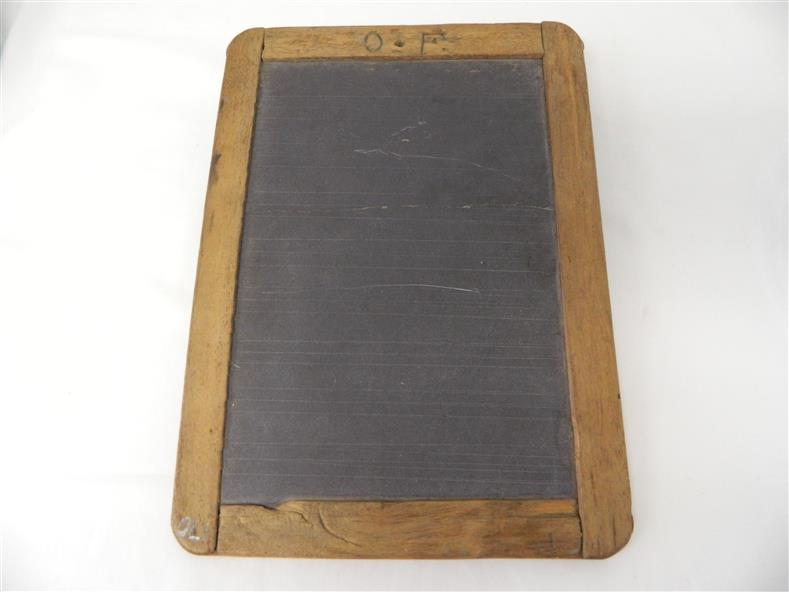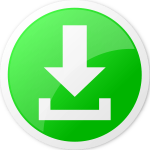This week’s Guess the Artefact challenge centres around an artefact used by generations of school children. There are some adults who may even have used these themselves when they were at school. It is interesting to see if modern students can recognise this object and work out how it was used. The picture below comes from the Victorian Collections website, managed by Museums Australia (Victoria). This website is a great source of images and texts from bygone days.

This object is rectangular and made of a relatively thin piece of black stone,measuring 25 x 17.5 cm, surrounded by 4 pieces of wood, which are a couple of centimetres wide. The corners of the wooden pieces have been rounded. There are several sets of faint parallel lines from left to right across the front of the stone, each pair of lines separated by a small gap. The back is plain, without parallel lines. The surface of the stone is slightly scratched. The letters “O.F” have been written and slightly incised into the topmost strip of wood. There is a small hole in between these two letters.
The dark stone is a fine-grained argillaceous (clayey) rock, called slate, which breaks naturally into thin slabs. In Australia, this rock was mined in South Australia, NSW and Tasmania in the 19th century. The dark surface of the stone reminds one of an object which was common in classrooms until fairly recently. Can you guess which one? They have been mostly replaced by whiteboards in modern classrooms. Yes, it does look similar to a blackboard, but much smaller.
The spacing of the lines is also important and might look familiar. Can you think of a familiar object, also used in classrooms, that has similar lines? Especially the ones used by younger students have similar lines. Yes, pre-ruled exercise books, with spacing for upper and lower case letters have very similar lines.
So it seems that we have a small blackboard-type object marked with lines for learning to write letters. In fact, that is exactly what this is! These objects were called “slates” (I’m sure you can work out why) and were used in place of exercise books by students in schools from the time that Australia was first settled by Europeans, throughout the colonial period in the 19th century and even into the 20th century. Some schools in Queensland continued to use them into the 1960s, but in most places exercise books were used from the 1920s or 1930s.

The slates marked with parallel lines were used by younger students learning to write and form their letters correctly, but they were also used for all lessons in many classes. In fact, younger children often struggled to manage the correct use of a slate pencil. The reverse side (with no lines) was used for writing Maths sums and drawing. Until the 1930s, when the bulk manufacture of paper from pulp made from eucalypt trees made paper more readily available, paper was relatively expensive. Thus, where books were provided to students, they were only given to older students, whom, it was hoped, would make less mistakes and would therefore waste less paper. Students used a pencil made from a softer kind of slate, which made white marks on the dark slate, or chalk, to write on the slate. The slate pencil was tied onto the slate using string or ribbon, tied through the hole in the top of the frame. A damp sponge was used to erase the work. Sometimes ‘books’ of 2 or 3 slates were tied together, but usually students would have to write down their lesson, have it checked by the teacher, memorise it and then erase what they had written. This would have meant that they had no notes and had to rely entirely on what they could remember when they wrote their exams!
In practise, sponges would get lost or dirty and students would spit on the slate and rub it out with their sleeves. The wear and tear on clothes led to complaints from parents. Students would also suck on the pencils, as they worked better when damp. Concerns were made about hygiene when using slates. In 1909, a School Medical Officer in the UK managed to culture the bacteria that causes diphtheria off the slate pencils in one particular class, and there were calls for the use of school slates to be discontinued. However, it was also noted that slates were easier to disinfect than paper.
Slates were also used in homes – for writing shopping lists and the like. Archaeological excavations of houses and schools from the 19th century have shown that slate pencils and writing slates were common. However, slate was also used for roofing tiles, which does confuse the evidence sometimes. Writing slates could be used over and over, unlike paper, which could only be written on once. This made slates significantly cheaper than paper for a long time.
Can you make a list of the Pros and Cons of using slates in classrooms? What would be different if you used slates today? How do you think using slates influenced the way lessons were taught in schools? Think about what could be taught and what could not…

 OpenSTEM’s
OpenSTEM’s  Student engagement is the primary aim of this curriculum implementation and a range of
Student engagement is the primary aim of this curriculum implementation and a range of  The
The  OpenSTEM’s History and Geography program provides a range of cross-curricular options. In particular Science extensions are provided to address the Science curriculum. Some aspects of the Mathematics curriculum also follow naturally from this material.
OpenSTEM’s History and Geography program provides a range of cross-curricular options. In particular Science extensions are provided to address the Science curriculum. Some aspects of the Mathematics curriculum also follow naturally from this material. Homeschooling parents also have great flexibility in their use of this material. The program is designed to be easily adaptable for the homeschooling situation. Parents can choose to use the resources within their own program, or allow the student to explore the material as their interest leads them. Alternatively, the parent can use the Teacher Handbook and Student Workbook to provide a series of lessons, knowing they will thus match all the curriculum requirements.
Homeschooling parents also have great flexibility in their use of this material. The program is designed to be easily adaptable for the homeschooling situation. Parents can choose to use the resources within their own program, or allow the student to explore the material as their interest leads them. Alternatively, the parent can use the Teacher Handbook and Student Workbook to provide a series of lessons, knowing they will thus match all the curriculum requirements.
The activities embedded in the programs make the subjects more engaging for the students as well as the teacher.
Trent Perry, Teacher